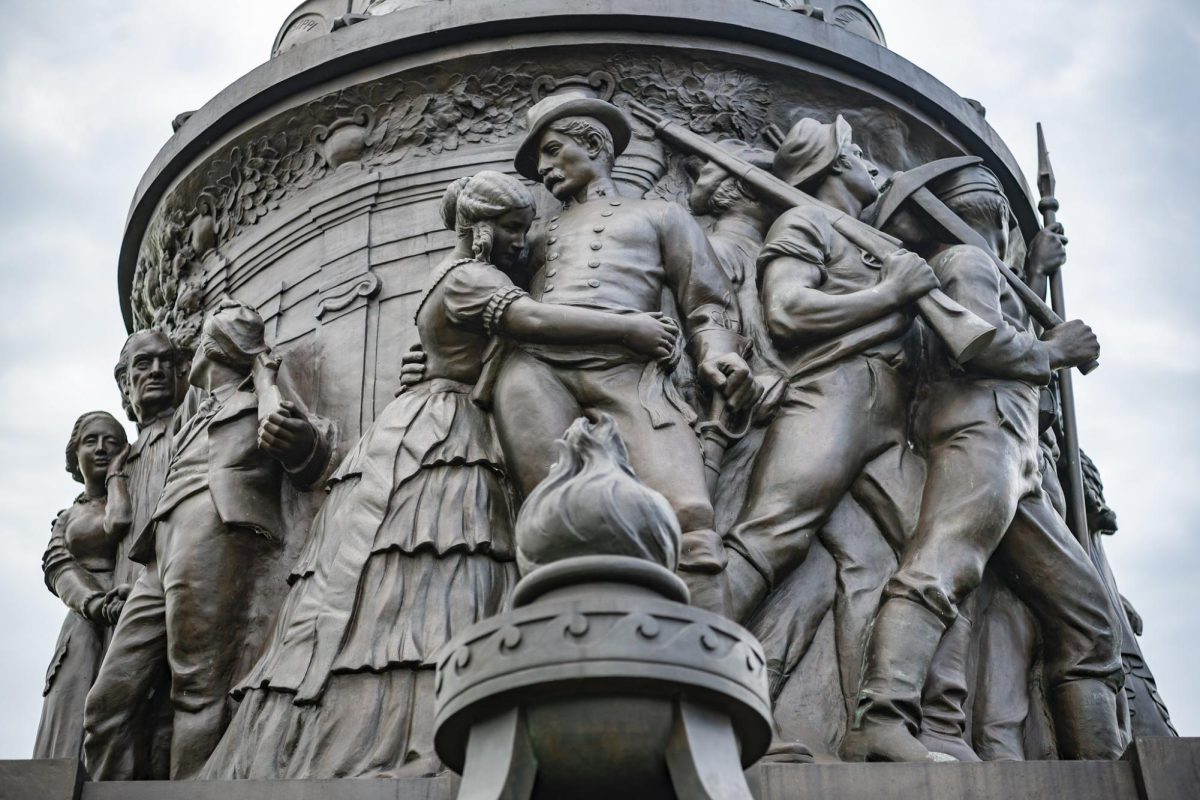“The spirit of secession is stronger today than ever,” warned Frederick Douglass, the formerly enslaved activist and leader in the abolitionist movement, in 1871. Douglass foreshadowed the resilience of the Lost Cause, a belief that shaped Southern culture in memory of the Civil War and that endured into the 21st century. This belief is an interpretation of the Civil War that “attempts to preserve the honor of the South” despite the North’s victory.
April 9th, 1865, marked the end of the American Civil War when Robert E. Lee, General of the Confederate Army, surrendered at Appomattox Court House. The conflict lasted for four years and remains the bloodiest war in American history. The Union ultimately won against the South fighting for independence and thereby began Reconstruction. Though the Union may have won the battles, the South had other plans for who had won the war, marking the emergence of the Lost Cause.
It would be a mistake to assume that Reconstruction magically ameliorated the lives of former African American slaves, but it did grant them constitutional rights, with some African Americans rising to power like Hiram Revels, the first African American member of the Senate. To many former white slave owners who were accustomed to racial superiority, it was a shock to see African Americans hold the same or more authority than them.
For the South as a whole, Reconstruction felt humiliating as it challenged the predominant social hierarchy and left Southerners feeling powerless. However, President Andrew Johnson’s lenient Reconstruction policies—allowing the Southern states to regulate slavery to freedom, frequently pardoning ex-Confederate leaders, and enabling them to establish new governments—led Southern states to quickly begin to implement Black Codes and continue their systematic oppression of African Americans.
Having regained power, the South channeled its humiliation into a belief that alleviated its shame: The Lost Cause. In 1866, author Edward A. Pollard expressed the Lost Cause’s key components in his book The Lost Cause, where he argued that the cause of the Civil War was not slavery but the South’s insistence on seceding from the North, even though slavery lay at the cause of the South’s secession. Pollard also depicts African American slaves as being content in bondage, minimizing the brutality and horrors of slavery and portraying Confederate soldiers as heroes who should be mourned. The Lost Cause ideology expressed that rather than fighting for slavery, the Confederacy fought for the noble cause of protecting their way of life from the North, who allegedly sought to destroy it.
As The Lost Cause grew popular, it became deeply embedded in Southern culture. Education was a key component in promoting The Lost Cause and institutionalizing the belief. A total of 69,706,756 students were enrolled in primary and secondary schools in the South from 1889-1969 and were subject to learning The Lost Cause. Schools followed guides like A Measuring Rod to Test Text books and Reference Book, written by white supremacist and author Mildred Lewis Rutherford, which advised schools to reject books that mentioned anything that could taint the Confederacy’s reputation, decreasing the exposure of any Confederate faults to students.
The United Daughters of the Confederacy (UDC), a society of the descendants of Confederate soldiers and those who gave aid to the Confederacy dedicated to memorializing the Confederacy, were key figures in influencing the school curriculum. The UDC ensured the textbooks used were those teaching The Lost Cause by publishing rubrics for schools to evaluate whether their textbooks properly propagated the ideology. They also hung portraits of Confederate figures and Confederate flags in state schools, even holding writing contests for students on topics relating to the Confederacy, like “The Origin of the Ku Klux Klan.” Thus, the Lost Cause was passed down from generation to generation.
The UDC was also prominent outside of the school setting. They are known for erecting monuments of Confederate “heroes,” like Robert E. Lee and Jefferson Davis, that still stand today in city squares, capitols, courthouse lawns, and other prominent places. Statues are typically built for noble and worthy heroes, which is precisely why the UDC built these figures: to glorify the Confederacy. The prominent figures of the Confederacy inevitably became worthy of reverence. The monuments also frequently had plaques explaining the Civil War in their own terms as a method of educating whoever came across the memorials.
Working with politicians also helped the UDC spread their ideologies. President William Howard Taft gave his approval to the UDC to build a Confederate statue in Arlington National Cemetery, a cemetery originally for Union soldiers, which would expand to include Confederate soldiers in 1900 in an attempt to alleviate tensions between the North and South.
The Confederate Memorial portrayed a tall bronze woman with an olive leaf crown, representing the South. At her feet is written, “They have beat their swords into plough-shares and their spears into pruning hooks,” a verse from the Bible, offering the idea that after the Civil War, the Confederates had put down their weapons and accepted peace and reconciliation.
Another engraving in the statue features a line from Pharsalia, a poem written by Roman poet Lucan about the Roman Civil War. In English translation from Latin, it reads, “The victorious cause was pleasing to the Gods, but the lost cause to Cato.” Cato refers to Cato the Younger, a highly influential politician during the Roman Republic, who is known for his virtue and opposition to tyranny. After losing the Roman Civil War, Cato committed suicide instead of accepting Julius Caesar’s rule, becoming a symbol of loyalty to his cause and freedom. Caesar represents the tyrannical, power-thirsty North, and Cato represents the South’s noble unwillingness to surrender their cultural values even after they lost the War. This portrayal of the North and South as tyranny versus freedom was bound to appeal to Southerners who felt that Northerners had infringed upon their freedom.
After its construction, Woodrow Wilson delivered his address, “Closing a Chapter,” at the cemetery on June 4th, 1914, supporting the monument and stating, “I am not so much happy as proud to participate in this capacity on such an occasion. Proud that I should represent such a people.” The encouragement of The Lost Cause by eminent figures like Taft and Wilson offered a sense of credibility to The Lost Cause, giving it the impression of nationwide acceptance.
Culture was another medium for spreading The Lost Cause. In the 20th century, directors produced films like Gone with the Wind, which romanticized life in the South before the Civil War, and Birth of a Nation with its controversial positive representation of the Ku Klux Klan and infamous use of blackface.
In 2020, Disney announced that its Splash Mountain ride, previously themed after the Song of the South, would be remodeled to a new design based on The Princess and the Frog. Song of the South was a Disney film released in 1946 about a boy who visits his grandmother’s plantation and befriends an ex-slave after the abolition of slavery. However, the film glorified the relationship between black and white people before and after liberation and reinforced stereotypes of African Americans being content with slavery and obedient toward white people.
Despite its evident racism, Song of the South was chosen as Splash Mountain’s theme and remained from 1989 to 2020. Though The Lost Cause may not have directly incited Disney’s choice to use Song of the South for the ride concept, the choice of the film shows just how much remnants of the ideology persisted.
During the peak of the Civil Rights Movement from 1959 to 1961, Mattel released Barbie Plantation Belle dolls designed as Barbie dolls with a frilly pink dress in the style of plantation life fashion. The Plantation Belle doll minimized the reality of brutality on plantations by focusing on the idealized image of wealthy white Southern women being graceful and refined instead of the widespread inhuman racist acts that characterized plantations.
While Mattel may not have created the doll with the sole purpose of promoting the Lost Cause, the doll still aligned with the Lost Cause’s idealized version of Southern plantation owners in the antebellum South. Despite its momentary production in 1959, the doll was relaunched in 2004, highlighting the lasting resonance of the Lost Cause in pop culture.
Today, Confederate flags are still proudly hung, Confederate memorials still stand, and the Lost Cause still remains in the South’s memory and identity. In many ways, the South won its war of redefining the Civil War. The narrative of the Lost Cause to the South tells of the preservation of their heritage and dignity. Yet, it pushes a romanticized perspective of the antebellum Southern life that reinforces racial stereotypes and downplays the cruel reality of slavery. In this way, it rewrites the South’s history, consequently shaping how future generations learn about America’s history of racism. To build an America that fulfills its promise of justice for all, we must realize the impact of the Lost Cause on the South’s perception of the Civil War and its lasting effects.








